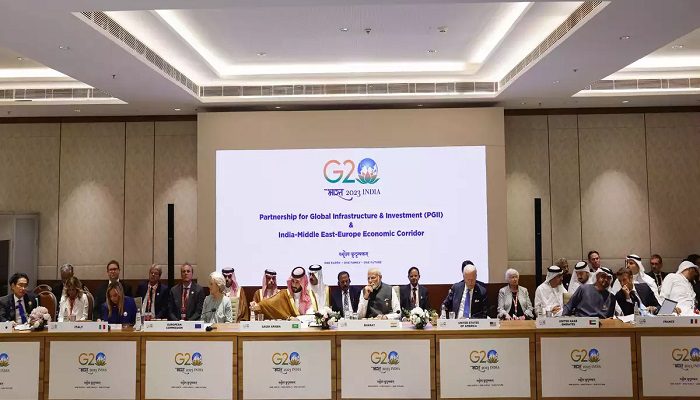The announcement made during the G20 summit about a multimodal transport and energy corridor connecting India and Europe through the Middle East represents a significant development in India’s pursuit of greater connectivity with the regions to its northwest following the partition.
For a long time, India has been concerned about China’s connectivity initiatives in the region through its Belt and Road Initiative and frustrated by Pakistan’s refusal to allow overland access. India had also been searching for a viable connectivity route into the Eurasian landmass through Iran. India has found a solution to connect with both Arabia and Europe.
The concept of linking India and the Arabian Peninsula through ship and rail connectivity arose during a meeting between National Security Adviser Ajit Doval and his U.S. counterpart Jake Sullivan in May 2023. Since then, this idea has gained significant momentum far more quickly than expected. The presence of key players such as the European Union, the United Arab Emirates, the United States, and Saudi Arabia in New Delhi for the G20 summit provided the perfect opportunity to unveil the formal framework for this transformative project.
This ambitious project entails constructing a railway line across the Arabian Peninsula through the United Arab Emirates and Saudi Arabia and enhancing shipping connections between India and Europe at either end of this corridor.
Furthermore, the corridor could be expanded to transport energy through pipelines and data via an optical fiber link. It might also involve the participation of other nations, such as Israel, once Riyadh and Tel Aviv establish normal diplomatic relations.
Several noteworthy geopolitical trends emerge from this project:
First, it challenges the previous belief in Delhi that India and the United States had little common interest in the Middle East. This project builds upon the cooperation between India, the United States, Israel, and the United Arab Emirates, setting the stage for potentially more significant collaboration.
Second, it breaks Pakistan’s veto over India’s overland connectivity to the West, a decades-long roadblock.
Third, while India maintains a relatively open relationship with Iran, tensions between Iran and the West have cast uncertainty over the commercial viability of corridors through Iran into Eurasia.
Fourth, the corridor deepens India’s strategic engagement with the Arabian Peninsula, allowing the Modi government to establish enduring connectivity between India and Arabia.
Fifth, this mega-connectivity project can potentially reduce tensions in the Arabian Peninsula by promoting intra-regional connectivity, which has long been a sought-after but elusive goal.
Sixth, it is evident that this corridor is being presented as an alternative to China’s Belt and Road Initiative, which several countries in South Asia, the Middle East, and Africa have embraced. The success of the new corridor will depend on its speed of implementation and its ability to address the sustainability challenges that have plagued the BRI.
Seventh, the involvement of the European Union in this project signals Europe’s engagement in infrastructure development in the region, making the EU a major stakeholder in connecting India with Arabia and Europe.
Finally, the United States and the European Union have also envisioned a plan to create a Trans-African corridor linking Angola, the Democratic Republic of Congo, and Zambia. India, which has increased its engagement with African nations, particularly those along the Indian Ocean coast, may seek to collaborate with the US and EU in Africa.
Preliminary data for Chinese engagement in the Belt and Road Initiative in the first half of 2023 show significant activity, with 102 deals valued at USD 43.3 billion. This amounts to about 60% of China’s BRI engagement in 2022, reflecting continued growth since the onset of COVID-19 in 2020.
In particular, the share of Chinese engagement through investments, as opposed to construction, has reached its highest level, accounting for about 59% of BRI engagement. This is a notable shift compared to 2021, when investments accounted for only 29% of BRI engagement.
The average deal size for investments has decreased, indicating a preference for smaller-scale projects. On the other hand, construction project deal sizes have also decreased, in line with the pursuit of “small or beautiful projects” and to address the challenges associated with larger projects.
Chinese BRI engagement has grown strongly in various regions, with Sub-Saharan Africa and South America leading. Middle Eastern countries continue to receive substantial Chinese engagement, although at a slightly reduced level compared to the previous year. East Asian BRI countries have also expanded their cooperation with China. Notably, South American BRI countries witnessed a significant increase in investments, even though there was no construction engagement in the first half of 2023.
China’s energy-related engagement in the BRI has become greener, with a substantial investment in solar, wind, and hydropower projects. This represents a significant shift toward environmentally friendly energy initiatives.
Despite the challenges in the global investment landscape, developing countries have shown increased interest in greenfield projects. India, in particular, has emerged as a major recipient of greenfield foreign direct investment, attracting significant R&D projects and becoming a prominent player.
China’s Belt and Road Initiative continues expanding, shifting towards greater investment activity and focusing on sustainable and green projects. Developing countries are increasing attractive destinations for foreign direct investment, with India standing out as a key beneficiary of these investments.






















